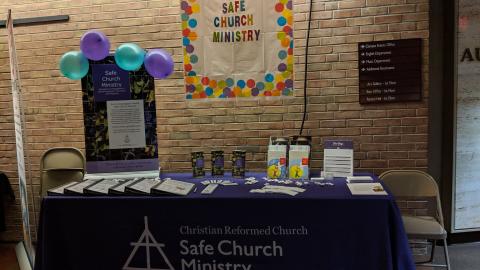Safe Church Teams: A Brief History of Safe Church Ministry
0 comments
326 views

In 1989, synod formed a study committee on abuse to report on the prevalence of abuse and ways to respond to it. The study committee presented a report to synod in 1992, the committee was re-appointed to bring a protocol for responding to allegations of abuse to synod in 1994. The study committee designed a protocol that included the use of an abuse response team (ART). The study committee based the need for a response team on three things.
First, other denominations were establishing similar teams to respond justly and effectively to abuse within their congregations. These included the Anglican Church of Canada, the United Church of Christ (US and Canada), the Episcopal Church (US and Canada), the Mennonite Church (Canada and the US), and the Evangelical Lutheran Church (US).
Second, the need for a team came from the experiences of survivors of abuse. The survivors informed the study committee that church councils and church leaders had not responded well to their allegations of abuse. These comments echoed overtures from Classes Niagara and Iakota who reported that churches were struggling to respond to allegations of abuse.
Third, the need for a team was based on the research conducted by the Calvin College Social Research Center. The report emphasized that the CRC mirrored the general population in the percentage of physical, sexual, and emotional abuse survivors. Nearly 28% of the adult membership of the CRC experienced abuse, either as a youth or as an adult. This percentage translates into thousands of people—many of whom admittedly also abused someone else (15%).
In addition, the report revealed where abuse had occurred: 4% in church, 4% in school, 4% in the community, 3% stranger/other, and 85% in the home. In 1994, synod formed the office of Abuse Prevention to replace the study committee. Beth Swagman was hired as director and continued development of the protocol that was begun by the study committee. A presentation of the team concept was made at Synod 1995. Additional study and more revisions were made over the next two years. Synod 1997 approved the concept of the abuse response team and the Advisory Panel Process. Synod encouraged every classis to appoint a team to carry out the work.
Teams were given three mandates, which continue into the present, to provide: education, support, and the Advisory Panel Process. Synod 2009 renamed the office of Abuse Prevention "Safe Church Ministry", to reflect a broader focus on abuse awareness, prevention and response.
Synod 2010 adopted a report from the Abuse Victims Task Force, which included revisions to the Advisory Panel Process along with many recommendations for classes and churches. For example: greater pastoral care for those victimized by abuse and their families, a reaffirmation and application of restorative justice principles, and an increase in educational resources to promote greater awareness and understanding of abuse.
In addition, the report included specific recommendations for church councils: the appointment of a person or group of people to ensure pastoral care in abuse situations, participation in annual training, and a plan to develop financial resources for abuse related counseling.
In March of 2011, Beth Swagman resigned as director of Safe Church Ministry. Bonnie Nicholas accepted the role of part time interim director during the search process. In November 2011, she accepted the position as director to continue the work.
A meeting of safe church team leaders in April of 2012 resulted in discerning key indicators or goals for churches. These indicators have become guiding goals that help define and prioritize the work of Safe Church Ministry. The committee that heard the Safe Church report at Synod 2014 drafted several recommendations, which were adopted. “That synod instruct the executive director to work with staff teams to explore ways of developing and promoting safe church teams in each classis.” And “that synod take note of the following five goals that continue to guide the work of Safe Church Ministry:
Synod 2016 adopted revisions to Church Order Supplements to article 82-84; the report included a discussion of the power dynamic involved in church leader misconduct. In addition, a recommendation was adopted, “That synod refer this report to the churches for study and for awareness of these important issues.” This paved the way for further discussions regarding abuse of power, which came to the fore at Synod 2018, and Synod 2019.
Staffing changes have improved the capacity of Safe Church; moving from a single director and administrative assistant to a staff team model, which includes a half-time safe church associate, and a quarter-time volunteer and communications specialist based in Canada. Eric Kas came on as Associate in March 2017. Miriam Spies was the first Safe Church Canadian employee starting in August 2018 (a joint position with Disability Concerns). Becky Jones is now filling that role, joining Safe Church in October 2019.
One focus for Safe Church Ministry is church leader misconduct; complex processes to prevent respond to that have, and are, being developed. Yet that is not our only focus. It's the broader culture that provides a context for abuse; therefore, we must be agents of cultural change, both in and outside of the church. In all the work of Safe Church, at every level, it is critically important that we never lose the voice of those who have experienced abuse. That voice, the collective voices, of those who have suffered abuse must be lifted up by Safe Church, so that the whole Church can hear. Only then will our prevention and response efforts be effective.
Safe Church, Leadership Development
Connect to The Network and add your own question, blog, resource, or job.
Add Your Post
Let's Discuss
We love your comments! Thank you for helping us uphold the Community Guidelines to make this an encouraging and respectful community for everyone.